Reversal of brain injury-induced prefrontal glutamic acid decarboxylase expression and working memory deficits by D1 receptor antagonism
- PMID: 16624944
- PMCID: PMC6673989
- DOI: 10.1523/JNEUROSCI.4687-05.2006
Reversal of brain injury-induced prefrontal glutamic acid decarboxylase expression and working memory deficits by D1 receptor antagonism
Abstract
Working memory (WM), the ability to transiently hold information in mind, is essential for high-level cognitive functions that are often impaired in brain-injured patients. The cellular and molecular mechanisms contributing to WM deficits, which can manifest in the absence of overt damage, in these patients are unknown. The function of the dorsolateral prefrontal cortex in humans and monkeys, and the medial prefrontal cortex (mPFC), in rodents is critical for WM. We demonstrate that controlled cortical impact injury of rats causes a long-lasting WM impairment that is associated with increased levels of the GABA-synthesizing enzyme glutamic acid decarboxylase 67 (GAD67) in the mPFC for up to 1 month after injury. A single administration of dopamine D1 antagonists at 14 d after injury is sufficient to decrease GAD67 levels and restore WM for at least 1 week. These findings indicate that inhibition of prefrontal neuronal activity contributes to WM deficits and that strategies to reduce GAD67 expression can offer prolonged WM improvement in brain-injured patients.
Figures
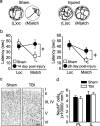
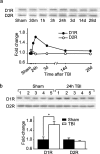
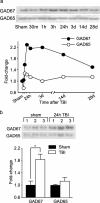


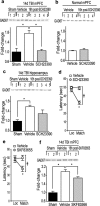
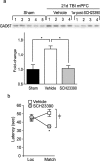
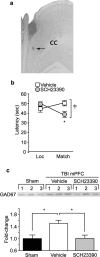
Similar articles
-
Persistent working memory dysfunction following traumatic brain injury: evidence for a time-dependent mechanism.Neuroscience. 2009 Mar 17;159(2):483-91. doi: 10.1016/j.neuroscience.2008.12.050. Epub 2009 Jan 3. Neuroscience. 2009. PMID: 19167462 Free PMC article.
-
Evidence for a differential medial prefrontal dopamine D1 and D2 receptor regulation of local and ventral tegmental glutamate and GABA release: a dual probe microdialysis study in the awake rat.Brain Res. 2004 Aug 13;1017(1-2):120-9. doi: 10.1016/j.brainres.2004.05.027. Brain Res. 2004. PMID: 15261107
-
Intra-medial prefrontal administration of SCH-23390 attenuates ERK phosphorylation and long-term memory for trace fear conditioning in rats.Neurobiol Learn Mem. 2004 Sep;82(2):65-70. doi: 10.1016/j.nlm.2004.04.006. Neurobiol Learn Mem. 2004. PMID: 15341790
-
Selective alterations in prefrontal cortical GABA neurotransmission in schizophrenia: a novel target for the treatment of working memory dysfunction.Psychopharmacology (Berl). 2004 Jun;174(1):143-50. doi: 10.1007/s00213-003-1673-x. Epub 2003 Dec 9. Psychopharmacology (Berl). 2004. PMID: 15205885 Review.
-
Glutamate and nicotinic receptor interactions in working memory: importance for the cognitive impairment of schizophrenia.Neuroscience. 2011 Nov 10;195:21-36. doi: 10.1016/j.neuroscience.2011.08.038. Epub 2011 Aug 22. Neuroscience. 2011. PMID: 21884762 Review.
Cited by
-
Changes in cortical plasticity after mild traumatic brain injury.Restor Neurol Neurosci. 2012;30(4):277-82. doi: 10.3233/RNN-2012-110207. Restor Neurol Neurosci. 2012. PMID: 22596356 Free PMC article.
-
Altered adrenergic receptor signaling following traumatic brain injury contributes to working memory dysfunction.Neuroscience. 2011 Jan 13;172:293-302. doi: 10.1016/j.neuroscience.2010.10.048. Epub 2010 Oct 23. Neuroscience. 2011. PMID: 20974230 Free PMC article.
-
Transcranial direct current stimulation for the treatment of motor impairment following traumatic brain injury.J Neuroeng Rehabil. 2019 Jan 25;16(1):14. doi: 10.1186/s12984-019-0489-9. J Neuroeng Rehabil. 2019. PMID: 30683136 Free PMC article. Review.
-
Chronic Cognitive Deficits and Associated Histopathology Following Closed-Head Concussive Injury in Rats.Front Neurol. 2019 Jul 2;10:699. doi: 10.3389/fneur.2019.00699. eCollection 2019. Front Neurol. 2019. PMID: 31312174 Free PMC article.
-
Activity-dependent development of inhibitory synapses and innervation pattern: role of GABA signalling and beyond.J Physiol. 2009 May 1;587(Pt 9):1881-8. doi: 10.1113/jphysiol.2008.168211. Epub 2009 Feb 2. J Physiol. 2009. PMID: 19188247 Free PMC article. Review.
References
-
- Akbarian S, Kim JJ, Potkin SG, Hagman JO, Tafazzoli A, Bunney WE Jr, Jones EG (1995). Gene expression for glutamic acid decarboxylase is reduced without loss of neurons in prefrontal cortex of schizophrenics. Arch Gen Psychiatry 52:258–266. - PubMed
-
- Anderson SW, Bechara A, Damasio H, Tranel D, Damasio AR (1999). Impairment of social and moral behavior related to early damage in human prefrontal cortex. Nat Neurosci 2:1032–1037. - PubMed
-
- Asada H, Kawamura Y, Maruyama K, Kume H, Ding R, Ji FY, Kanbara N, Kuzume H, Sanbo M, Yagi T, Obata K (1996). Mice lacking the 65 kDa isoform of glutamic acid decarboxylase (GAD65) maintain normal levels of GAD67 and GABA in their brains but are susceptible to seizures. Biochem Biophys Res Commun 229:891–895. - PubMed
Publication types
MeSH terms
Substances
Grants and funding
LinkOut - more resources
Full Text Sources
Medical
